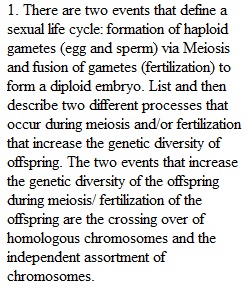


Q Complete the following and submit the Word document by midnight Sunday. Remember to include complete citations for all sources used to answer each question. 1. There are two events that define a sexual life cycle: formation of haploid gametes (egg and sperm) via Meiosis and fusion of gametes (fertilization) to form a diploid embryo. List and then describe two different processes that occur during meiosis and/or fertilization that increase the genetic diversity of offspring. 2. Which two phases of mitosis are essentially opposites in terms of changes in the nucleus? Explain your choice. This should include what is going on with the chromosomes as well as the nucleus. 3. What are four characteristics (behaviors) of all cancer cells? 4. We commonly believe that benign tumors are not harmful. Is this true or false? Explain why you made that decision. 5. Describe and explain the warning signs of melanoma. (ABCDs) 6. Meiosis and mitosis are both processes that involve nuclear division. Demonstrate your understanding of these two processes by completing the table below: Mitosis Meiosis Occurs in what type of cells in humans? [[[[[[[ [[[[[[[ Produces what type of cells in humans? [[[[[[ [[[[[ Are daughter cells identical or different to each other? [[[[[ [[[[[ Are daughter cells the same or different than the parent cell? [[[[[ [[[[[ What is the ploidy of the cells produced? [[[[[[ [[[[[[ How many cells are produced [[[[[[ [[[[[[ 7. Daughter cells resulting from meiosis: a) have only one member of each homologus pair b) have only one member of each pair of alleles c) have half as many chromosomes as the parent cell d) all of these e) none of these. 8. The centromere is a region in which: a)chromatids remain attached to one another until anaphase. b) metaphase chromosomes become aligned at the metaphase plate. c) chromosomes are grouped during telophase. d) the nucleus is located prior to mitosis. e) new spindle microtubules form at either end. 9. Which of the following does not occur during mitosis? a) condensation of the chromosomes b) replication of the DNA c) separation of sister chromatids d) spindle formation e) separation of the spindle poles. 10. What is the relationship between interphase and cell division; meaning why must each must occur in order for the other one to proceed? Be specific. ________________________________________ The following Grading Rubric will be used to score your homework: Questions Expectation Points 1 Correctly identifies and explains the processes. 0-3 2 Identifies and explains the two phases that are opposite. 0-3 3 Correctly lists the four characteristics. 0-4 4 Clearly and correctly justifies choice. 0-4 5 Descriptors and explanations provided. 0-6 6 Differentiates correctly between mitosis and meiosis. 0-6 7-9 Demonstrates an understanding of this unit’s concepts. 0-6 10 Explains the relationship correctly. 0-4 TOTAL {{{{{{{{{{ 36 pts PreviousNext
View Related Questions